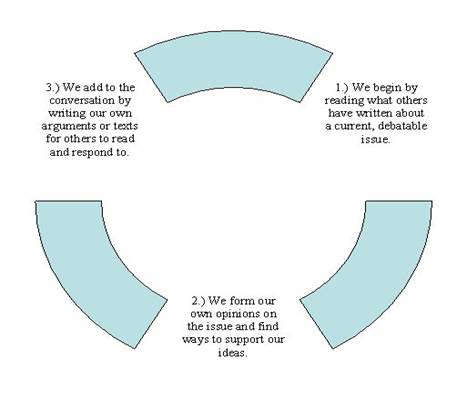Day 1 (Monday, August 24)
Lesson Objectives
Students will
Prep
After orientation last week, you're well prepared to teach your first class (even if you feel like you're not!). To get ready for Day 1, reread the syllabus introduction, revisit the first few readings you'll assign, prepare your materials (see the list below), ask for any help you need (the instructors are here for you!), and write out your own lesson plan.
Materials (be sure to bring materials for each of your classes)
Lead-In
Some students may have prepared for class today by buying the textbook. Also some may have set up Writing Studio accounts. Today is unique because it's a fresh start. Your students will come in with few ideas about what the class will be about, what the atmosphere will feel like, etc. One of your primary tasks for today is to establish a classroom culture that will work for you and your students, and to give students a fair idea of what they can expect for the rest of the semester.
Activities
Introduce yourself and the course (3-5 minutes)
Before class begins, write your name, the course number, section, and title on the board. Once all (or most) students have arrived, take a moment to introduce yourself—tell students what you would like them to call you, and consider what else you'd like them to know about you. Make sure everyone is in the right place—have students check their schedules to be sure that they're really in your section.
Attendance (5 minutes)
Use your roster to call names and make note of anyone who is absent. After you have called all the names on your list, make a general statement that if a student isn’t on the roster to see you after class. Possible reasons why the student isn't on your roster include:
Distribute and review your syllabus (10-15 minutes)
Spend time looking at the document with your students. Discuss the course description, your contact information, your grading system, and key course policies. You might not discuss every single thing in detail; if you don't (and even if you do), remind students to reread the document before the next class and to email you with any questions or concerns.
Distribute and explain yellow slips about CO150 drop policy (2 min)
Student introductions (10-15 minutes)
Choose one of the introduction activities below, or use another that accomplishes the goals of allowing students to make connections with each other and setting precedents about participation and community.
Option 1: In this activity, students pair up and interview each other; then they introduce each other to the rest of the class. Here are instructions which you can put on an overhead:
Introductions
Option 2: In this activity, you generate a handful of questions with the class and then go around the room and allow each student time to answer the questions. You can start out with the obvious—write, "What's your name?" on the board. Ask the students what else they'd like to know about each other. Give them time—if nobody suggests anything, make another suggestion. Something like "What's your major?" works and might get them going with more suggestions. Once you have four or five questions listed, end with one of your own. Feel free to answer the questions yourself.
Option 3: In this activity, you begin to get the students exploring their beliefs about writing. Students have been writing for some time now, and as such have considerable prior knowledge, so it is good to reexamine beliefs to determine if those beliefs are accurate or helpful. Until they do this, any new learning in the subject can be limited. Tell students to form groups of 3-4 to discuss their writing beliefs. Here are instructions you can put on an overhead. Have students agree or disagree with each belief and explain why?
Writing Beliefs
From the list below, identify the one belief about writing that you agree with most strongly, and one that you’re convinced isn’t true.
Reconvene as a class, and have each group briefly summarize their discussion for the class.
Introduce the Idea of Writing as a Conversation Model (3-5 minutes)
Explain the ways in which writing is similar to conversation. Here’s a sample explanation:
Like a conversation, writing involves exchanges of ideas that help us shape our own ideas and opinions. It would be foolish to open your mouth the moment you join a group of people engaged in conversation—instead, you listen for a few moments to understand what’s being discussed. Then, when you find that you have something to offer, you wait until an appropriate moment to contribute. We all know what happens to people who make off-topic, insensitive, or otherwise ill-considered remarks in a conversation.
The following is a visual representation of the way in which this course is designed around the writing as conversation metaphor. Before explaining, present it to students on an overhead:

Conclude and assign homework for Wednesday (3-5 minutes)
Put the homework on an overhead transparency, explain it, and allow students time to copy it down. If you plan on using the calendar function on Writing Studio to post homework, encourage students to find homework there.
Conclude class
Wrap up today's class and point students forward to Wednesday's class.
Connection to Next Class
Today you've taken care of a lot of "business" and you've prepared students for what they can expect next time. On Wednesday, you'll introduce the course theme: “The Rhetoric of Green.” You will also introduce students to some fundamental course concepts.
Teacher Post-script
You might take a moment to reflect on today's class, to assess what went well and what could have gone better (and go easy on yourself—you're probably way more aware of what you did or didn't say/do than your students are!), and to make notes about anything you need to remember for next time. Be sure to check email now and then before Wednesday so that you can help students out with questions, Writing Studio issues, etc.